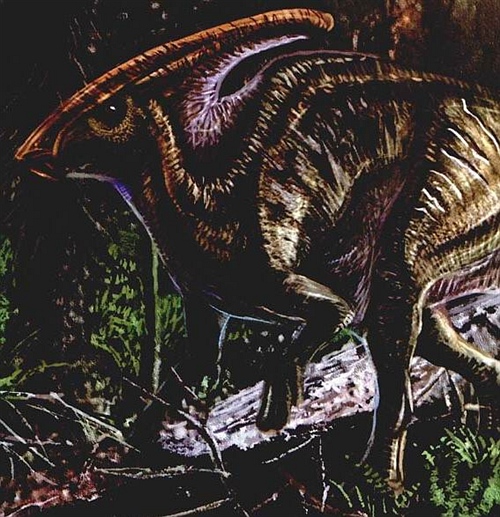The crest contains the animal's nasal cavity-a tube that loops around twice, creating a chamber two and a half meters long.
頭冠包含有這種動物的鼻腔——一個雙循環的管道形成了一個2.5米長的腔體。
Calls, vibrations originating in the voice box, travel along these tubes.
來自喉部的聲音和振動在這條管道中穿行。
Like the chambers of a trombone, those tubes amplify and lower that sound.
就像長號的套管一樣,這些管道將聲音擴大并降低頻率。
The result-an extremely low-frequency hum, even deeper than a foghorn.
使之變成頻率極低的嗡嗡聲,比船上霧角的聲音還要低。
Each species has its own distinct shape. Each species would have its own distinct sound.
每個物種都有其獨特的外形。也具有獨特的聲音。
The arrangement of the chambers inside each animal is unique.
各個物種的音室都是與眾不同的。
And the sound they create like a fingerprint.
因此發出的聲音就像指紋一樣獨一無二。
These calls are Parasaurolophus' primary form of defense.
這些聲音就是副櫛龍最主要的防御手段。
They are communicative, social beings that live in herds.
它們是善于溝通的群居動物。
Parasaurolophus have learned there's safety in numbers.
它們知道只有群居才更安全。
An isolated Parasaurolophus would be a dinosaur in trouble.
一旦落單,副櫛龍就很可能有危險。
It's gonna have to look out for predators on its own.
就需要獨自面對捕食者的威脅。
And therefore, a lone individual might do its call to say, "I'm alone,"
因此落單的副櫛龍就會發出"我落單了"的聲音,
and wait to hear for other members of its herd to make the corresponding call.
等候族群的其它成員回復的信號。
This tactic is still used today on the plains of Africa.
這種策略仍被今天非洲草原上的動物沿用。

If you look at various species of plant eaters, they live together in groups,
如果你去觀察各種食草動物會發現它們都是群居的,
and if one of them spots a predator, they can whinny or hoot and let the rest of the herd know,
如果它們中的一個發現了捕食者,它們會發出不同聲響警示其它成員,
so that they can keep on alert, or if the predators are right there,
所以它們可以保持警惕,就算捕食者已經很靠近,
they can all break out into a run and run away from the attacker.
它們也可以迅速逃離躲避捕食者的進攻。
Parasaurolophus' ability to communicate complex messages is a tremendous defensive advantage.
副櫛龍這種傳遞復雜信息的能力是很了不起的防御手段。
Using its sensitive hearing, these creatures can detect a predator far off in the distance.
利用敏感的聽覺,它們可以在很遠以外就感知到捕食者的蹤跡。
Then send out an alarm call to warn the herd.
然后發出信號警示族群。
Even more effective, low-frequency sounds,
更有效的是,低頻聲音波長較長,
with their long wavelengths, travel much further than high frequencies.
比高頻聲音傳播得更遠。
These are kinds of sounds that can be transmitted over very long distances.
它們發出的聲音可以傳到非常非常遠的地方。
This extremely low-frequency sound is called infrasound and can travel for miles.
這種極低頻率的聲音稱為次聲波,能傳播幾英里。
You can produce a noise so low and so deep not only it goes through the air,
極低頻的聲音不僅能在空氣中傳播,
it goes through the rocks and through the soil, and you pick it up in your feet.
而且能在巖石和土壤中傳播,用腳就能感知到。
Elephants do that. Rhinos do that. Hippos do that. Crocodiles do that. Alligators do it. They produce infrasound.
大象就會用次聲交流,犀牛也會。還有河馬,鱷魚,短吻鱷。它們都能發出次聲波。
But for a Parasaurolophus, these calls can be used for more than just communication.
但對副櫛龍來說,這種聲音不僅用來交流。
Low-frequency infrasound can put up an aggressive form of defense. lnfrasound is a weapon.
低頻次聲波也是一種進攻性防御措施。次聲波也是一種武器。
You can scramble the brains of your enemy with a blast of infrasound.
強烈的次聲波能給敵人的大腦造成混亂。
If you have 100 duckbills, 1,000 duckbills, facing the same direction, producing high-decibel sounds,
比如一百只甚至一千只鴨嘴科恐龍面對同一方向發出高分貝聲音,
that's a wave of energy that could knock over a predator or at least discombobulate it, scramble its brains.
這種聲波的能量能擊倒一個捕食者,至少讓它神志不清,思維錯亂。
Despite packing a deafening secret weapon, a Parasaurolophus, like other plant eaters,
盡管有這種振聾發聵的秘密武器,副櫛龍和其它食草動物一樣,
knows that the best way to stay alive is to keep predators at a distance.
明白真正的生存之道在于與捕食者保持距離。



